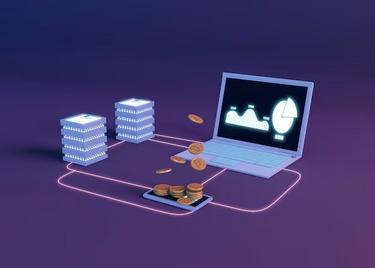Digital asset
Digital assets represent a broad spectrum of binary data, including but not limited to digital files such as images, videos, audio recordings, software, and more. These assets are distinguished by their creation, distribution, and usage in digital form, leveraging the power of the internet and digital technology to reach a global audience. The advent of digital assets has revolutionized various industries, including media, entertainment, software development, and online retail, by providing a new medium for content delivery, marketing, and transaction.
- Characteristics of Digital Assets
- Types of Digital Assets
- The Role of Digital Assets in the Economy
- Legal and Ethical Considerations
- Challenges and Future Outlook
- Understanding Digital Assets in Crypto
- Types of Digital Assets
- Benefits of Digital Assets
- Challenges and Considerations
- The Future of Digital Assets
Characteristics of Digital Assets
Digital assets are inherently intangible, existing only in digital format but holding significant value due to their content, usage rights, and the information they contain. They are easily reproducible and shareable, which presents both opportunities and challenges in terms of copyright and digital rights[1] management (DRM). The accessibility and distribution of digital assets are facilitated by digital platforms and the internet, making them readily available to a wide audience across the globe.
Types of Digital Assets
Digital assets encompass a wide range of digital formats:
- Digital Currencies[2]: Such as cryptocurrencies[3] that use cryptography[4] for security.
- Digital Rights: Including music, videos, and other media that are protected by copyright laws.
- Software and Applications: Programs used for various digital processes.
- Digital Documents: E-books, PDFs, and other document formats that are used for digital communication.
Digital assets encompass a wide variety of formats and types. Media files such as images, videos, and audio clips are among the most recognized forms. Software and applications represent another significant category, including both commercial products and open-source projects. Digital documents and e-books offer a digital alternative to traditional paper-based media, while web assets like websites and social media profiles are critical for online presence and digital marketing efforts.
The Role of Digital Assets in the Economy
The digital economy has been significantly shaped by the rise of digital assets. They are instrumental in content creation, digital marketing, and e-commerce, enabling businesses to reach wider audiences and engage with customers in innovative ways. Digital assets also play a crucial role in the monetization strategies of content creators and marketers, providing new revenue streams and business models in the digital age.
Legal and Ethical Considerations
Navigating the legal and ethical landscape of digital assets involves understanding and respecting intellectual property rights[2], ensuring data privacy[5], and securing digital content against unauthorized access and use. The dynamic nature of digital media and the ease of reproduction pose unique challenges in copyright management and enforcement, necessitating robust legal frameworks and ethical practices[6].
Challenges and Future Outlook
Managing and leveraging digital assets comes with a set of challenges, including but not limited to copyright risks, data storage concerns, and ensuring accessibility. As digital technology continues to evolve, so too will the tools and systems for digital asset management, promising more sophisticated solutions for the storage, distribution, and monetization of digital content. The future of digital assets is inextricably linked to advancements in technology, legal frameworks, and market demands, suggesting a landscape of continuous innovation and growth.
In the rapidly evolving landscape of digital finance, digital assets in the crypto field represent a profound shift in how value and ownership are defined, exchanged, and stored. Digital assets, broadly encompassing cryptocurrencies, tokens, and other forms of digital value units, have ushered in a new era of financial instruments. These assets leverage blockchain[7] technology to ensure security, transparency[8], and decentralization[9], challenging traditional financial systems[10] and offering innovative ways for investment, trading, and wealth creation.
Understanding Digital Assets in Crypto
Digital assets in the crypto field are characterized by their use of cryptography for security, decentralized control as opposed to centralized digital currency[11]/banking systems, and their existence on blockchain or distributed ledger technology[12]. The most well-known digital asset, Bitcoin[13], was introduced in 2009 as the first decentralized cryptocurrency[14]. Since then, the space has grown exponentially to include a wide variety of digital currencies, utility tokens, security tokens[15], and non-fungible tokens (NFTs), each serving distinct purposes and functions within and beyond the financial sector.
Types of Digital Assets
- Cryptocurrencies: These are digital or virtual currencies that use cryptography for security and operate on a decentralized network, primarily used as a medium of exchange[16] or store of value. Bitcoin and Ethereum[17] are prime examples.
- Utility Tokens: These tokens provide access to a specific product or service within a network. They are often used in Initial Coin Offerings (ICOs) to raise capital for blockchain projects.
- Security Tokens: Representing investment contracts into an underlying investment asset, such as stocks, bonds, or real estate, security tokens are subject to regulatory oversight[18] and offer a digital alternative to traditional forms of investment.
- Non-Fungible Tokens (NFTs): Unique digital tokens that represent ownership or proof of authenticity of a specific item or asset, such as digital art, collectibles, or even real estate, leveraging blockchain technology to ensure their uniqueness and ownership.
Benefits of Digital Assets
Digital assets offer several advantages, including reduced transaction costs and times, thanks to the elimination of intermediaries; increased accessibility, allowing anyone with internet access to participate in the digital economy; enhanced security and transparency, with blockchain providing a tamper-proof ledger[19] of transactions; and innovation in financial products and services, offering new forms of investments, fundraising mechanisms, and asset management tools.
Challenges and Considerations
Despite their benefits, digital assets face challenges, including volatility[20], with prices subject to rapid fluctuations; regulatory uncertainty[21], as governments and financial institutions grapple with how to classify, regulate, and tax these assets; security risks, from hacking and fraud; and market adoption, as acceptance by mainstream financial services and consumers is still in progress.
The Future of Digital Assets
The future of digital assets in the crypto field is marked by both opportunities and challenges. As technology advances and regulatory frameworks evolve, the potential for digital assets to transform the financial landscape continues to grow. Innovations in blockchain technology, increased institutional adoption, and the development of more stable and secure platforms suggest a bright future for digital assets.
In conclusion, digital assets in the crypto field represent a fundamental shift in the digital economy, offering new opportunities for investment, trading, and the democratization of finance. As the market matures and addresses its challenges, the role of digital assets is set to become increasingly central to the global financial system.
- Digital rights — Rights that allow individuals to own, use, and distribute digital content under specific conditions.
- Digital currencies — Digital forms of money that exist only in electronic form, not in physical form like coins or notes.
- Cryptocurrencies — Digital or virtual currencies that use cryptography for security and operate on a decentralized system, unlike traditional currencies.
- Cryptography — The practice of securing communications to prevent third parties from reading them, used in digital currencies for securing transactions.
- Data Privacy — The aspect of data protection that deals with the proper handling, processing, and storage of personal information to protect individuals' privacy rights.
- Ethical Practices — The moral principles guiding the conduct of gambling operators, including honesty, integrity, and responsibility.
- Blockchain — A decentralized digital ledger recording cryptocurrency transactions across multiple computers.
- Transparency — The characteristic of blockchain technology that allows all transactions to be visible and verifiable by all network participants.
- Decentralization — Distribution of power away from a central authority in the management of cryptocurrencies.
- Financial systems — Complex systems comprising different institutions, including banks, markets, currencies, and policies, that support economic activities.
- Digital Currency — A digital or virtual currency that uses cryptography for security, making it difficult to counterfeit.
- Distributed Ledger Technology — A digital system for recording the transaction of assets in which the transactions and their details are recorded in multiple places at the same time.
- Bitcoin — The first and most well-known cryptocurrency, was introduced in 2009 by Satoshi Nakamoto, who developed Bitcoin.
- Cryptocurrency — Digital or virtual currency secured by cryptography, facilitates secure, anonymous transactions.
- Security Tokens — Digital tokens that represent ownership or an interest in real-world assets, subject to regulatory compliance.
- Medium of Exchange — An intermediary instrument used to facilitate the sale, purchase, or trade of goods between parties.
- Ethereum — A blockchain platform with its own cryptocurrency, Ether, is known for smart contract functionality.
- Regulatory Oversight — The supervision by authorities to ensure that market participants comply with legal and ethical standards.
- Ledger — A digital record of all cryptocurrency transactions, maintained across several computers in a distributed manner.
- Volatility — Rapid and significant price movement, a common characteristic of cryptocurrencies.
- Regulatory Uncertainty — The lack of clear regulatory guidelines and frameworks governing the use and trading of virtual assets.
- https://en.wikipedia.org/wiki/Digital_asset
- https://www.forbes.com/sites/forbestechcouncil/2020/07/29/understanding-digital-assets-in-the-modern-world/



